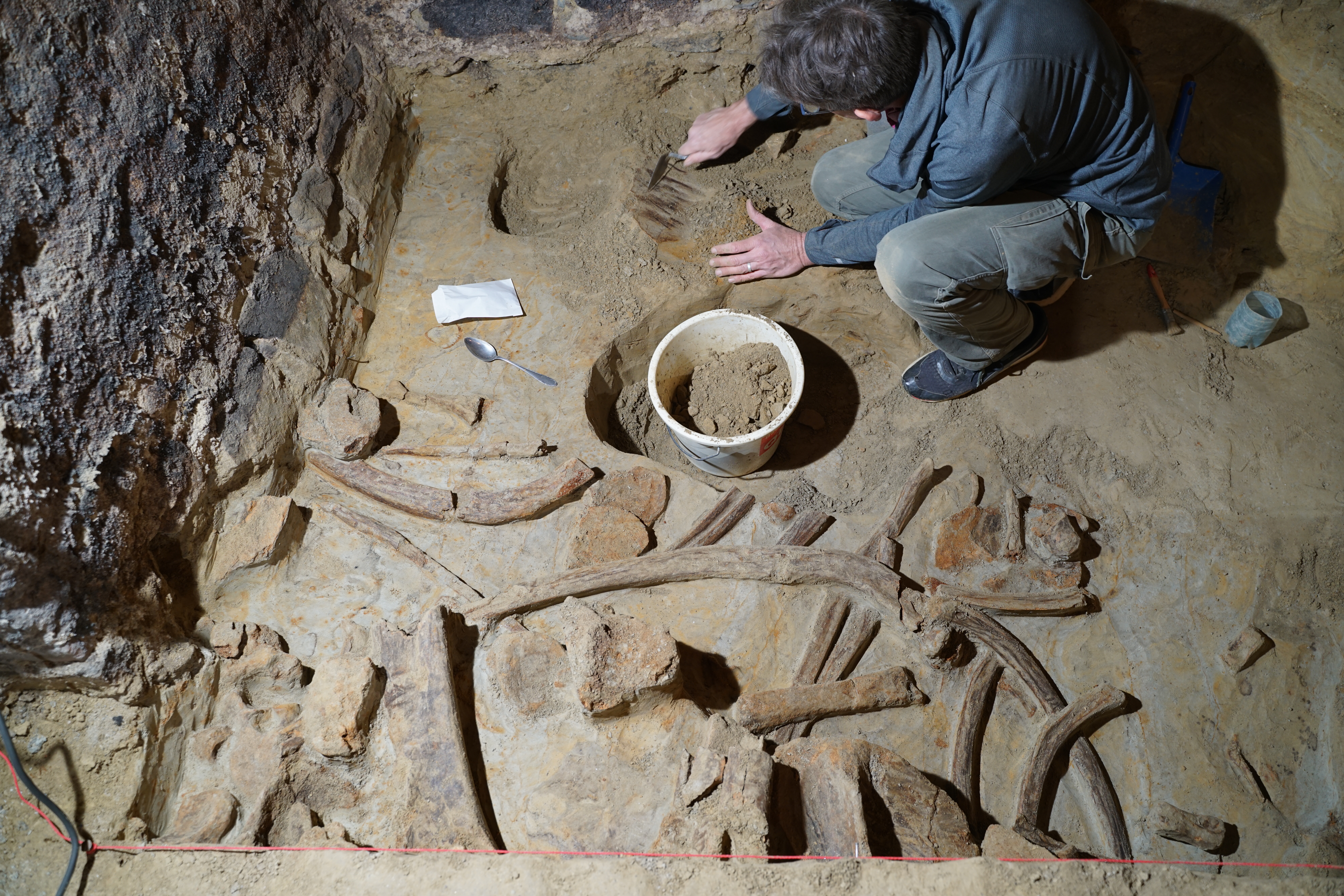Extinction
3D DNA Preserved for 52,000 Years in Freeze-Dried Woolly Mammoth Remains
For the first time, researchers have mapped ancient genetic material in unprecedented detail
Has Life on Earth Survived More Than Five Mass Extinctions?
Scientists aren’t just arguing whether humans are causing a sixth mass extinction event now, but whether many more occurred in the past
What Killed the Last Woolly Mammoths? Scientists Say It Wasn't Inbreeding
New research suggests some catastrophic event—such as a natural disaster or a virus—killed the world's last known population of mammoths on Wrangel Island
'Frog Saunas' May Be the Key to Saving Amphibians From a Deadly Fungal Infection
Providing frogs with sun-warmed bricks inside mini-greenhouses can help them recover from chytrid and make them more resilient against the disease in the future, a new study finds
A Giant Interstellar Cloud May Have Once Enveloped Earth, Potentially Causing Ice Ages
Astronomers suggest this cold, dense cloud compressed our sun's protective field between two and three million years ago, leaving the Earth exposed to cosmic material
Meet the 'Echidnapus,' an Extinct Creature That Resembles Both the Echidna and Platypus of Today
The species is among three newly identified monotremes, or egg-laying mammals, discovered from fossils in Australia that are shedding light on the odd animals' evolution
More Than a Century Ago, Flamingos Disappeared From Florida. Now, They're Coming Home
Likely transported by Hurricane Idalia last August, more than 100 of the pink birds were counted in a February census in the Sunshine State, where they are considered a native species
Austrian Man Discovers Hundreds of Mammoth Bones While Renovating His Wine Cellar
Owner Andreas Pernerstorfer thought he'd found a piece of wood, but then he remembered something his grandfather had said about finding teeth in the cellar decades ago
These Massive, Extinct Salmon Had Spiky Teeth Like a Warthog's Tusks
For decades, scientists thought the teeth pointed downward, similar to those of a saber-toothed cat, but now they believe the fish's chompers jutted out sideways
World's First IVF Rhino Pregnancy Could Save a Nearly Extinct Subspecies
Only two northern white rhinos remain, but the new reproductive breakthrough may pull them back from the brink of erasure
Doomsday Clock Stays at 90 Seconds to Midnight Amid Climate Change, War and A.I.
For the second year in a row, the clock is the nearest it has ever been to signaling our total annihilation
Meet Elma, a Woolly Mammoth Who Roamed Far and Wide More Than 14,000 Years Ago
By analyzing a fossilized tusk, scientists have pieced together the animal's movements
What Caused the Mysterious Extinction of 'Giganto,' the World's Largest Ape?
The massive primates were unable to shift their diet to keep pace with a changing climate, according to a new study, forcing them to eat less nutritious bark and twigs
California Grizzlies Weren't as Big—or Bloodthirsty—as People Once Thought
The now-extinct bears were mostly vegetarians and measured about the same size as today's North American grizzlies
Humans May Have Driven Twice as Many Bird Species to Extinction as Previously Thought
Statistical modeling of undiscovered extinctions suggests 1,430 bird species have disappeared during modern human history
Scientists Uncover a Golden Mole Species Thought to Be 'Possibly Extinct'
A scent-detecting dog led the team to the discovery in South Africa, and traces of mole DNA helped confirm it
Fossil Hunter Pulls Massive Mammoth Jawbone Out of Florida River
John Kreatsoulas, who made the discovery while diving in southwest Florida, initially thought the 60-pound mandible was a log
Dust May Have Triggered the Global Winter That Killed the Dinosaurs
A new study, based on modeling, suggests fine silicate particles could have blocked sunlight and shut down photosynthesis across the globe
Climate Change Is Pushing Many of the World's Amphibians Closer to Extinction
Just over 40 percent of amphibian species are at risk of going extinct, and humans' fossil fuel use is partly to blame, according to a new assessment
Scientists Collect First RNA From an Extinct Tasmanian Tiger
No other RNA has ever been extracted from an extinct species, so the breakthrough opens doors to understanding the biology of long-gone organisms
Page 1 of 17
:focal(600x400:601x401)/https://tf-cmsv2-smithsonianmag-media.s3.amazonaws.com/filer_public/9d/03/9d03e8f0-5b0e-4445-b90a-69b96ccf49b0/imrs_1.png)
:focal(800x602:801x603)/https://tf-cmsv2-smithsonianmag-media.s3.amazonaws.com/filer_public/89/bb/89bbc077-3a82-480c-99e6-0758e58f3e74/massextinctions.jpg)
:focal(1280x817:1281x818)/https://tf-cmsv2-smithsonianmag-media.s3.amazonaws.com/filer_public/03/54/0354cbb8-1c5f-4d56-856b-1789f070550b/mammoth-tusk-on-wrangel-island-2017-photo-love-dalen-scaled.jpg)
:focal(446x286:447x287)/https://tf-cmsv2-smithsonianmag-media.s3.amazonaws.com/filer_public/f9/f7/f9f713b6-b855-4bb0-8ea6-387a1c2da7a3/green-gold-bell-frogs-waddle-1200.jpg)
:focal(537x445:538x446)/https://tf-cmsv2-smithsonianmag-media.s3.amazonaws.com/filer_public/e8/b6/e8b68174-1c9b-465e-8469-b66151dd09fa/heliosphere.jpg)
:focal(517x379:518x380)/https://tf-cmsv2-smithsonianmag-media.s3.amazonaws.com/filer_public/5a/2c/5a2c8abd-95de-4b9f-a80a-045996094de7/age_of_monotremes__echidnapus_bottom_right_ilustration_by_peter_shouten.jpeg)
:focal(1500x1000:1501x1001)/https://tf-cmsv2-smithsonianmag-media.s3.amazonaws.com/filer_public/aa/fd/aafd53cf-c15c-4e26-9abd-fc3036574298/gettyimages-959583750.jpg)

:focal(593x507:594x508)/https://tf-cmsv2-smithsonianmag-media.s3.amazonaws.com/filer_public/fb/4f/fb4fa92d-5623-4ba5-b7cb-9e3402486a48/spike_tooth_profile_press_ray_troll.jpg)
:focal(2069x1557:2070x1558)/https://tf-cmsv2-smithsonianmag-media.s3.amazonaws.com/filer_public/94/43/944309b6-e35e-4c44-bd78-7d48261d8348/unnamed_cropped.jpg)
:focal(2527x1685:2528x1686)/https://tf-cmsv2-smithsonianmag-media.s3.amazonaws.com/filer_public/a0/61/a061b5c1-5c7d-4bc0-b3d9-68a9f69eb908/gettyimages-1459150477.jpg)
:focal(512x341:513x342)/https://tf-cmsv2-smithsonianmag-media.s3.amazonaws.com/filer_public/d7/93/d7937ea8-25b4-42d5-976b-57dc156d80bc/karen-spaleta-sampling-swanpoint-mammoth-tusk-1-1024x682.jpg)
:focal(1440x933:1441x934)/https://tf-cmsv2-smithsonianmag-media.s3.amazonaws.com/filer_public/fe/11/fe11489c-890c-4f3a-bdf3-cc0eff2913c5/the-extinction-of-the.jpg)
:focal(1024x585:1025x586)/https://tf-cmsv2-smithsonianmag-media.s3.amazonaws.com/filer_public/d3/11/d3111f19-4c47-4b13-99ff-9bf6b452c3cb/49185352476_9ee103e012_k.jpg)
:focal(616x463:617x464)/https://tf-cmsv2-smithsonianmag-media.s3.amazonaws.com/filer_public/99/40/994052a2-a377-465d-b9e7-b4eb43bb6d57/ai-image-possible-extinctbirds3.jpg)
:focal(2016x1517:2017x1518)/https://tf-cmsv2-smithsonianmag-media.s3.amazonaws.com/filer_public/e0/a0/e0a00c5e-4103-49be-9ed0-7682e2352a89/20221116_063506.jpg)
:focal(720x542:721x543)/https://tf-cmsv2-smithsonianmag-media.s3.amazonaws.com/filer_public/26/c9/26c9ad1d-3d47-4983-8439-d95fc00720b6/400220364_362017989722004_4470277198971332636_n.jpg)
:focal(1095x688:1096x689)/https://tf-cmsv2-smithsonianmag-media.s3.amazonaws.com/filer_public/f3/90/f39056b5-7c45-426c-a79c-5ab95976b673/gettyimages-1683351339.jpg)
:focal(2604x1761:2605x1762)/https://tf-cmsv2-smithsonianmag-media.s3.amazonaws.com/filer_public/58/c3/58c3b8ff-e9f7-40b0-85f1-bc7ddce04bd0/gettyimages-586117348.jpg)
:focal(2579x1744:2580x1745)/https://tf-cmsv2-smithsonianmag-media.s3.amazonaws.com/filer_public/51/fe/51fe033d-c648-459d-a09e-a04603f5ed7c/gettyimages-946150422.jpg)